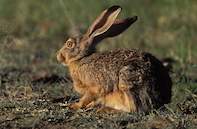Name
The Cape hare, common hare or brown hare (lepus capensis). There are twelve subspecies of the Cape hare throughout Africa.
Appearance
The Cape hare’s fur is of a pale brownish-grey colour, with a black and white tail and long ears. The female is slightly larger than the male, their mass differing from 1.5 to 2.5 kg. The Cape hare differs from the scrub hare in being smaller and not having purely white underparts.Cape Hare Diet
The Cape hare either browses or grazes, depending on the supply of the shrubs and grass on which it feeds. They re-ingest soft faecal pellets from the anus when resting during the day, and when feeding nocturnally excrete hardened pellets.Cape Hare Breeding
Being a non-seasonal breeder, the Cape hare breeds throughout the year in South Africa. Births tend to peak during the rainy season. After 42 days of gestation, one to three leverets are born weighing 100 grams each.
The leverets are fully furred at birth and their eyes are open. They are able to move around and hear within 48 hours after birth. The female suckles the leverets for only ten minutes each night, and lactates for a short three weeks providing no nest for the litter.
 Learning about the mammals of South Africa is now so much easier for all South Africans - SouthAfrica.co.za is an excellent source of inform...
Learning about the mammals of South Africa is now so much easier for all South Africans - SouthAfrica.co.za is an excellent source of inform...